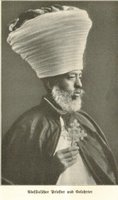 This is the true story of how the Ethiopian army led by Atse (Emperor) Yohannes completely destroyed and annihilated an Egyptian army invasion force led by American Confederate generals. The humiliating part of this tragic event for the Confederate generals was that they had already been losers in the American civil wars which was fought over the question of slavery. A couple of generals have preserved the secrets of this events and how they despised the Egyptian Fellahin (peasants) and the barbarous Ethiopian patriots. This is the story of the battles of Gunda-Gundet and Gura and Arissa in which the Ethiopians completely annihilated the coalition armies of the Ottoman Turks, Egyptian and Confederate American generals as written by the American Colonel William M. Dye. The book is erroneously titled Moslem Egypt and Christian Abyssinia because it was more a war of the coalition forces of Egypt, the Ottomans and the Confederate Americans against Ethiopia. An illustration above from the book depicts an Ethiopian horseman, a Sudanese Kababich, an Egyptian soldier and an Ethiopian Oromo fighter surrounding Pompous Egyptian rulers. The shield with the lion probably represents the Ethiopian emperor's emblem as Yohannes had 4 lions with him at all time. The Egyptians and Ottomans hatched a new and secret idea of recruiting confederate American generals and officers in 1869. These corrupt and unaware Americans were secured by Blacque Bey, the Turkish minister at Washington D.C. A five year contract was drafted obligating the officers to serve against countries Egypt was at war with except the United States. The Americans eventually realized that they would be fighting against Christian Abyssinia (Ethiopia). The famous American general, W.T. Sherman recruited in confidence most of the forty eight Americans . One is left to ponder whether the American administration at that time was in fact knowledgeable about the conspiracy against Ethiopia that was hatching right under their noses. My opinion is that the United Stated knew about this conspiracy, assisted in the transportation and covered up the deal. This was also a good way to get rid of the defeated unemployed confederate officers in Washington D.C. and the South. Following are the names of those who served the Egyptians; Brigadier Generals, W. W. Loring (Leader of Group), C. C. Sible, Carrol Tevies, C. P. Stone, Major General Henry A Mot, Majors W. C. Campbell, Parrys, Hunt, Eugene Fehet, Chansler M. Martin, W. B. Hall, White, J. D. Dennison, Charles F. Loshe, Robert Schrryler, H. G. Prout, C. Macomb Mason, Colonels Alexander Reylands, T. G. Rheet, W. H. Jenifer, Beverly Kennon, Frank Reynolds, Vanderbilt Allen, R. C. Colston, W. McE. Dye, Robert M. Rogers, Samuel H. Lockett, Charles B. Field and McIvor, Lieutenant Colonels Sparow Purdy, C. C. Long, Will Ward, Wm. W. Dunlap, James Bassel, H. B. Reed, C. J. Graves, H. C. Derrick, Captains Freeman, James Morgan, David Essex Portal, Irgens, John Savage, Drs Johnson, W. H. William, Arlson, Professor L. H. Mitchell, Misters Middleton, Testaferrata and Garnard.
This is the true story of how the Ethiopian army led by Atse (Emperor) Yohannes completely destroyed and annihilated an Egyptian army invasion force led by American Confederate generals. The humiliating part of this tragic event for the Confederate generals was that they had already been losers in the American civil wars which was fought over the question of slavery. A couple of generals have preserved the secrets of this events and how they despised the Egyptian Fellahin (peasants) and the barbarous Ethiopian patriots. This is the story of the battles of Gunda-Gundet and Gura and Arissa in which the Ethiopians completely annihilated the coalition armies of the Ottoman Turks, Egyptian and Confederate American generals as written by the American Colonel William M. Dye. The book is erroneously titled Moslem Egypt and Christian Abyssinia because it was more a war of the coalition forces of Egypt, the Ottomans and the Confederate Americans against Ethiopia. An illustration above from the book depicts an Ethiopian horseman, a Sudanese Kababich, an Egyptian soldier and an Ethiopian Oromo fighter surrounding Pompous Egyptian rulers. The shield with the lion probably represents the Ethiopian emperor's emblem as Yohannes had 4 lions with him at all time. The Egyptians and Ottomans hatched a new and secret idea of recruiting confederate American generals and officers in 1869. These corrupt and unaware Americans were secured by Blacque Bey, the Turkish minister at Washington D.C. A five year contract was drafted obligating the officers to serve against countries Egypt was at war with except the United States. The Americans eventually realized that they would be fighting against Christian Abyssinia (Ethiopia). The famous American general, W.T. Sherman recruited in confidence most of the forty eight Americans . One is left to ponder whether the American administration at that time was in fact knowledgeable about the conspiracy against Ethiopia that was hatching right under their noses. My opinion is that the United Stated knew about this conspiracy, assisted in the transportation and covered up the deal. This was also a good way to get rid of the defeated unemployed confederate officers in Washington D.C. and the South. Following are the names of those who served the Egyptians; Brigadier Generals, W. W. Loring (Leader of Group), C. C. Sible, Carrol Tevies, C. P. Stone, Major General Henry A Mot, Majors W. C. Campbell, Parrys, Hunt, Eugene Fehet, Chansler M. Martin, W. B. Hall, White, J. D. Dennison, Charles F. Loshe, Robert Schrryler, H. G. Prout, C. Macomb Mason, Colonels Alexander Reylands, T. G. Rheet, W. H. Jenifer, Beverly Kennon, Frank Reynolds, Vanderbilt Allen, R. C. Colston, W. McE. Dye, Robert M. Rogers, Samuel H. Lockett, Charles B. Field and McIvor, Lieutenant Colonels Sparow Purdy, C. C. Long, Will Ward, Wm. W. Dunlap, James Bassel, H. B. Reed, C. J. Graves, H. C. Derrick, Captains Freeman, James Morgan, David Essex Portal, Irgens, John Savage, Drs Johnson, W. H. William, Arlson, Professor L. H. Mitchell, Misters Middleton, Testaferrata and Garnard.In 1875, Egyptian forces under Munzinger, a Swiss, were annihilated at Arissa. This was an attempt by Ismael Pasha of Egypt to bypass Yohannis and communicate with Menelik of Shoa. The Egyptians then tried a second trick again in 1875 under the Dannish Colonel Ahrendrup Bey (Bey being a Turkish promotion). This army of Egypt was again destroyed by Atse Yohannis at Guda Gundet in 1875. The third trick that the Egyptians and their Ottoman masters tried was to bring the Arab army of Egypt under the American Confederate Army of W.W. Loring. It is this story that is being told here because it was kept largely in the limelight due to the utter annihilation and humiliation of the “white” armies (The coalition forces of Egypt, Turkish Ottomans and Confederate Americans) by the African armies of Atse Yohannis. In effect Ethiopia, an African country, fought three continental armies of North American led by Colonel Loring, Asia Minor led by the Ottomans and quasi-African-Arab-European Egypt led by Ismael Pasha, the Khedive of Egypt. The plans of the Khedive to conquer the “Barbarian Habashis” and take their Blue Nile Basin was childish in itself as the Ethiopians with little arms that they possessed, had a more sophisticated and intelligent plan that sent the pitiful invaders running to the shoreline of Mistewa (Massawa) where they were having real fits of nervous breakdowns.
The notable battle on the plains of Gura was described by Dye and others very starkly. The Gura battle plan was arranged by the council of the Confederate Americans General Loring, Derrick and Dye and the Egyptian Osman Pasha. In this bloody fight, the Ethiopians overwhelmed the Egyptian-Ottoman-Confederate American coalition forces into oblivion. The invaders retreated after being mauled by the Ethiopian lions (literally mauled because there were 4 lions of Emperor Yohannes that growled and pawed the air in the heat of the battle). Colonel Dye describes the Ethiopian frenzy as “beating and blowing the “Negariths and Aimbeltas arousing their barbarous souls to fury and combat”. He further describes how Dejach Hagos of Shire was killed during the battle on horseback while the cowardly Egyptian Prince Hassan rides away on his horse to Massawa and his cavalry gallop away too. The Egyptian foot soldiers meanwhile staggered all the way to the sea shore following their leaders. Dye bitterly refers to the Egyptians as Fellahin which means peasants, not worthy of being soldiers, no doubt to relief himself of his own shortcomings. Indeed the American battle-hardened confederate armies were also fleeing the battle grounds. The infamous names of the defeated Americans were Long, Lockett, Hall, Dennison, Johnson, Wilson, Porter, Field, Martin, Dye, Colston, Stone, Gravis, Loshe, Lamson, Loring, Derrick, Wilson and Irgens.
One of the casualties of the battles against the Egyptians and their mercenaries were the imperial lions of Atse Yohannis, symbols of Ethiopia. A lion or two were lost at Gundet while two were lost at Gura. Colonel Dye reports that one of these lions was stuffed and placed near a tree for all to see its majestic powers.
Throughout the fight of preserving the Independence of the country, Ethiopia always had to deal severely with enemies from within the country itself. Thus one of the products from this victory was that the Egyptians settled for a more devious method of creating a division within the people of Ethiopia by using Ethnic tensions and propaganda ploys. The strangest character from this method was an opportunist Ethiopian known as Ras Wolde Mikael. His allegiance shifted between the Arabs and the Ethiopians. At times he laid waste to the Hamasein province and on other occasions he allied with Ras Alula to beat away the Egyptians. The method still continues in the 21st century with many Wolde Mekaels created by the Egyptians to once and for all attempt to revenge their defeat and bring powerful united Ethiopia into many weak fiefdoms that would endlessly kill each other.
The president of the United States at this time, Andrew Johnson, is described by the Miller Center as “Though Johnson was deeply committed to saving the Union, he did not believe in the emancipation of slaves”. Clearly as president he did not care about the destruction of Ethiopia and as such knew the on-goings of the Sherman-Turkish minister deal in Washington. Further more the Center describes him as “Andrew Johnson is largely viewed as the worst possible person to have been President at the end of the Civil War. He utterly failed to make a satisfying and just peace because of his racist views, his gross incompetence in federal office, and his incredible miscalculation of public support for his policies”. His Secretary of State was a certain Seward who “worked to prevent European recognition of the Confederacy during the Civil War”. There is no doubt that Seward, at the same time, instigated and gave the green light to the Confederate General Sherman to recruit and ship the secret mercenaries to Egypt to kill the Ethiopians and capture the Nile Basin and Maritime lands of Ethiopia. Sherman was also commander-in-chief of the United States between 1865-1883 and his recruiting of confederate armies against Ethiopia took place at this time. In the end however almighty Ethiopia prevailed.
Further readings: Loring http://stonewall.hut.ru/leaders/loring.htm and Sherman http://www.civilwarhome.com/sherbio.htm







